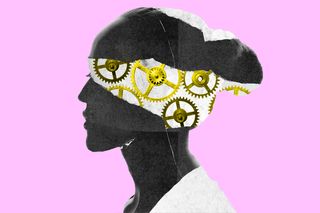
Cognitive Behavioral Therapy Was a Therapy Mainstay – Why’s It Getting a Bad Rap?
Many argue that CBT oversimplifies complex human experiences, and invalidates our reaction to systemic issues.

Cognitive behavioral therapy (CBT) has long been celebrated for its efficacy in treating various mental illnesses — including depression and anxiety — besides equipping people to deal with issues pertaining to self-esteem, motivation, procrastination, or even interpersonal relationships. But in recent years, with growing conversations about mental health, CBT has also come under scrutiny and criticism — with many arguing that it oversimplifies complex human experiences, invalidates our reaction to systemic issues, and promotes a culture of positivity which isn’t always helpful.
The question, however, is whether the modality itself is at the core of the invalidation, or simply, a poor application of the approach. The goal of CBT is to enable a client to identify the “cognitive distortions and maladaptive responses that are coming in their way of achieving the goals they have set for themselves.” Samriti Makkar Midha, a psychotherapist from Mumbai, who practices CBT, had told The Swaddle in 2021, explaining how it’s an action-oriented approach that follows a structured framework to help people learn how to manage their mental health concerns within a short span of time — ranging between eight to 12 weeks. But the promise of a “quick solution” is where the problem might lie.
“In the short term, it genuinely helped me… But in the long term, it turned out to be less helpful. When I get in the habit of challenging every negative thought I feel, I end up skipping straight to the ‘feeling better’ part and not doing a really important step — fully experiencing the negative feeling and really exploring where it came from,” Lauren Bunke from Chicago, who was treated with CBT to address her depression and anxiety, wrote, adding: “Maybe, I was just doing the technique wrong. But the therapist who taught it to me would usually do the same thing… She taught me not to linger on and feel negative thoughts.” Bunke discovered later that her depression and anxiety stemmed from trauma. But because she rarely had to chance to delve deeper into her “negative feelings” during her CBT sessions, it lay buried.
We live in an age where quick and easy is all the rage. And CBT — to a certain extent — seems to cater to that.
Related on The Swaddle:
Is Your Therapist Responsible for Making You a ‘Better’ Person?
On the one hand, clients often approach therapists expecting them to be problem-solvers who would “fix” their issues with a swish and a swirl of their magic wands. On the other, “CBT is relatively easier than other therapies to teach, in a sense. It also requires lesser vulnerability on the part of the therapist, and is less exhausting, too, in a way — only emotionally, though; it can be quite exhausting intellectually. Nonetheless, people tend to think that doing a preliminary course in CBT would teach them how to use it exceptionally well,” psychotherapist Zohra Master, an associate fellow and supervisor from the Albert Ellis Institute, points out. At the confluence of this pursuit of shortcuts — by therapists and clients alike — lies the potential for invalidation.
“From the first session, therapists told me my way of thinking was the problem, not the medical conditions I couldn’t control or things like systemic injustices, financial struggles, trauma, and discrimination… CBT as a modality is based around gaslighting,” says Alana Saltz, a disabled writer and activist. “I believe CBT is built to be dismissive and invalidating. And that’s what was done to me for so long that even I wondered at times if maybe I was causing my own pain, that if I ‘fixed’ my thinking and could stop being anxious, my pain would get better. But two decades of therapy only made me feel more lost and confused.” For years, Saltz was invalidated by therapists and told that even the physical pain she was experiencing was simply in her head — only to be diagnosed with chronic migraine and hypermobile Ehlers-Danlos Syndrome, a connective tissue disorder, later.
Saltz’s experience resonates with many individuals who have experienced trauma and systemic abuse — suggesting the possibility that some practitioners of CBT may inadvertently dismiss the lived experiences of survivors, reinforcing societal biases and invalidating the legitimacy of their emotions.
Even so, it’s not CBT itself that’s the problem, but the manner in which it is applied — especially so, since practitioners aren’t often trained to use a systemic lens to look at mental health issues, as Jahan Ara, a trauma-informed therapist from Pakistan, explains.
Related on The Swaddle:
Ara acknowledges the merits in the arguments against CBT, but believes its a lack of self-awareness among therapists, besides their inability to empathize with survivors of systemic injustices, that’s a bigger problem, noting how “many therapists see the issue as within the individual.”
According to her, CBT can, however, be adapted to respect the realities of the real world and the valid concerns of clients without invalidating them, but “the therapist has to be someone who recognizes social issues. Then, it would have to be a whole conversation on the model of the ‘right way of thinking’ and ‘wrong way of thinking’ because what’s the basis for these obvious classifications?” She believes that therapists who are aware of gender politics, poverty, religious and social issues, and the other systemic injustices, do incorporate that awareness while practicing CBT.
Concurring, Master emphasizes on the importance of combining CBT with other forms of therapy, in order to lend a more humanistic approach to the treatment. “CBT emphasizes a lot more on thought than on emotions. So, there’s inadvertently a lack of focus — not a complete absence, however — on the emotional component that is important and required in therapy sessions. [Still,] it’s easy to just put all the weight on one therapy and say, ‘this therapy is good’ or ‘that therapy is bad;’ in reality, as therapists, we need to have an understanding of a couple of therapies in relative depth to help them get the whole picture and make these therapies more holistic and more potent for the clients.” Explaining further, she adds, “With CBT, I can look at the thought; [when coupled] with a more humanistic approach, or let’s say, an emotion focused approach, I can look at the human aspect of it.”
“[A] therapist will know what to incorporate when; it is a significant part of the training experience.”
Devrupa Rakshit is an Associate Editor at The Swaddle. She is a lawyer by education, a poet by accident, a painter by shaukh, and autistic by birth. You can find her on Instagram @devruparakshit.
Related


More Than 63% of Indian Women’s Cancer Deaths Were Preventable: Lancet Study
